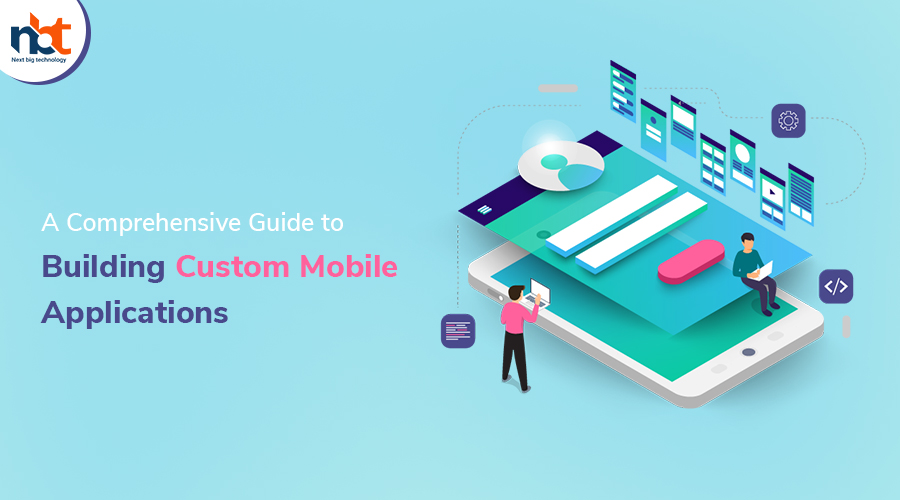Introduction:
In today’s digital world, businesses are increasingly realizing the importance of having custom mobile applications to meet their unique needs and enhance user experiences. Custom mobile applications offer tailored functionalities, seamless integration with existing systems, and the ability to stand out in a crowded market. If you’re considering building a custom mobile application for your business, this comprehensive guide will walk you through the step-by-step process. From defining your objectives to selecting the right development approach, designing the user interface, implementing custom features, and launching your app, we’ll cover everything you need to know. Let’s get started!
- Define Your Objectives and Requirements:
The first step in building a custom mobile application is defining your objectives and requirements. Clearly identify what you want to achieve with your app. Consider factors such as the target audience, desired functionalities, integration with existing systems, scalability, and security requirements. Defining your objectives and requirements upfront will help guide the development process and ensure that your app aligns with your business goals.
- Choose the Right Development Approach:
There are two primary development approaches for building custom mobile applications: native development and cross-platform development.
a. Native Development: Native development involves building separate applications for different platforms (e.g., iOS and Android) using platform-specific programming languages (Swift or Objective-C for iOS, Java or Kotlin for Android). Native development offers optimal performance, access to platform-specific features, and a native user experience. However, it requires separate development efforts for each platform.
b. Cross-Platform Development: Cross-platform development allows you to build a single codebase that can run on multiple platforms. Frameworks such as React Native and Flutter enable developers to write code once and deploy it across iOS and Android platforms. Cross-platform development offers cost and time efficiency while still providing a native-like user experience. However, it may have limitations in accessing certain platform-specific features.
Choose the development approach that best suits your requirements, budget, and time constraints.
- Design the User Interface (UI) and User Experience (UX):
Designing an intuitive and visually appealing UI/UX is crucial for a custom mobile application. Start by creating wireframes and prototypes to visualize the app’s layout, navigation flow, and user interactions. Pay attention to elements such as color schemes, typography, iconography, and user-friendly navigation. Aim for a seamless and delightful user experience that reflects your brand’s identity and enhances engagement.
- Develop Custom Features and Functionalities:
The next step is developing the custom features and functionalities that make your app unique. This may include integrating with external APIs and services, implementing custom workflows, creating interactive elements, and incorporating personalized user experiences. Work closely with your development team to ensure that the custom features align with your objectives and requirements.
- Integrate with Existing Systems:
If you have existing systems or databases that your mobile application needs to interact with, integration is a critical step. Ensure proper communication and data exchange between your mobile app and backend systems. APIs or web services can be utilized to establish a seamless integration, allowing your app to retrieve and update data in real-time.
- Implement Security Measures:
Security is of utmost importance when building custom mobile applications. Implement appropriate security measures to protect user data and ensure secure communication between the app and backend systems. Consider encryption techniques, secure authentication mechanisms, data storage best practices, and compliance with relevant regulations such as GDPR or HIPAA, if applicable to your app.
- Test, Test, and Test:
Thorough testing is crucial to ensure that your custom mobile application functions as intended and provides a seamless user experience. Conduct functional testing, usability testing, performance testing, compatibility testing, and security testing across different devices and operating systems. Identify and fix any bugs or issues before launching your app to ensure high quality and reliability.
- Publish and Promote Your App:
Once your custom mobile application has been thoroughly tested, it’s time to prepare it for launch. Register developer accounts with the relevant app stores (e.g., Apple App Store and Google Play Store) and follow their guidelines to submit your app for review. Develop a marketing strategy to promote your app, including app store optimization (ASO), digital advertising, social media marketing, content marketing, and influencer partnerships. Leverage various channels to increase visibility and attract your target audience.
- Monitor, Analyze, and Update:
After launching your custom mobile application, it’s crucial to monitor its performance, analyze user behavior, and gather feedback. Implement analytics tools to gain insights into user engagement, usage patterns, and app performance. Continuously iterate and update your app based on user feedback, technology advancements, and evolving business requirements. Regular updates and improvements are key to maintaining user satisfaction and staying competitive in the ever-evolving mobile app landscape.
Conclusion:
Building a custom mobile application requires careful planning, thoughtful design, and efficient development. By defining your objectives and requirements, choosing the right development approach, designing an intuitive UI/UX, implementing custom features, and thoroughly testing your app, you can create a mobile application that meets your unique business needs and engages users effectively. Remember to prioritize user experience, implement robust security measures, integrate with existing systems, and continuously monitor and update your app to ensure its success. With dedication, innovation, and a user-centric approach, your custom mobile application can become a valuable asset that sets your business apart in the digital world.









